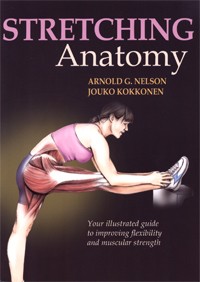 |
|
Fitness Tip of the Day!
|
|
Prediabetes in Teens and Young Adults
|
|
In the US, 18% of teens and 24% of young adults now have prediabetes. (source: JAMA Pediatrics, Dec. 2, 2019)
|
|
 |
 |
 |
|
 |
|
|
Stretching Anatomy
|

|
| Author: |
Nelson A, Kokkonen J |
| Category: |
Fitness |
| Audience: |
Consumer |
| Length: |
147 pages |
| Publisher: |
Human Kinetics |
| Year Published: |
2007 |
| List Price: |
$19.95 |
|
|
|
|
AthleteInMe.com®
Rating:


 Good
Good
Stretching Anatomy is a concise, though detailed, encyclopedia of stretches.
• Recommended for: This book is intended to be a guide for consumers. However, the liberal use of the Latin medical terms for specific muscles suggests that Stretching Anatomy could be a useful resource for undergraduate students in exercise science or physical therapy.
ABOUT THE AUTHORS
• Arnold G Nelson, PhD, is an associate professor in the department of kinesiology at Louisiana State University. He earned his PhD in muscle physiology and is a fellow of the American College of Sports Medicine.
• Jouko Kokkonen, PhD, is a professor in exercise science at Brigham Young University in Hawaii. He earned his PhD in exercise physiology. He has taught anatomy, kinesiology, and exercise physiology for over 20 years. He has also coached track and field for 35 years.
CONTENT
The 147 page book is organized as follows:
- Chapter 1: Neck
- Chapter 2: Shoulders, Back, and Chest
- Chapter 3: Arms, Wrists, and Hands
- Chapter 4: Lower Trunk
- Chapter 5: Hips
- Chapter 6: Knees and Thighs
- Chapter 7: Feet and Calves
REVIEW
The strength of this book is that it is simultaneously concise yet thorough. Multiple anatomical illustrations are provided for every single stretch. Not much text is provided, which is good: Each section begins with a single page of text, single-spaced, and in small font. It's hard to read.
The illustrations, however, are well done. They show a person performing the stretch, accompanied by detailed anatomical drawings of the muscles involved. In my opinion, these gross anatomy diagrams are lost on all but the most curious consumer. On the other hand (no pun intended), the anatomical illustrations along with the proper Latin names for the specific muscles make this book useful in an undergraduate classroom.
And that is my only criticism: is the intended audience the consumer, or, the undergraduate student? Like many academic authors, Nelson and Kokkonen allow medical terminology to clutter up an otherwise useful consumer resource. For example, why do authors persist in calling a hamstring stretch a "knee flexor stretch"? Use terms that consumers understand.
• What I Liked About This Book: illustrations, simplicity.
• What Could Be Better: eliminate the medical terminology; bolded sub-headers would make the half-page discussion of "Types of Stretching" more readable; the section "Benefits of Stretching" could be more informative: tell readers the effects of stretching on injury prevention, performance, and injury recovery.
SUMMARY
Stretching Anatomy is a useful book. Consumers can benefit from the many illustrations and the accompanying guidelines. Undergraduate students in exercise sciences and physical therapy may also find this to be a useful resource.
| Reviewed by: Stan Reents, PharmD |
6/2/2014 4:47:44 PM |
|
|
 |
|
 |
|
|
|
 |
 |